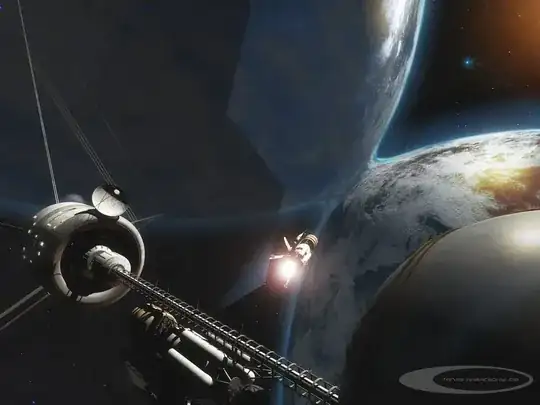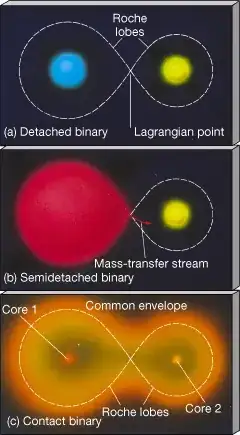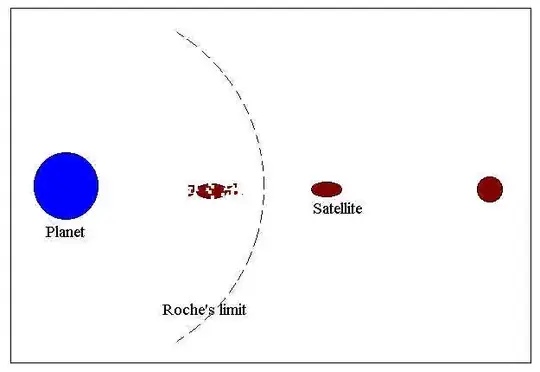Could two planets be tidally locked to each other at such a small distance from one another that they share their atmosphere, and material is floating around between the two?

Could two planets be tidally locked to each other at such a small distance from one another that they share their atmosphere, and material is floating around between the two?

The Roche Limit alluded to in other answers may not be a barrier to this.
Rigid Approximation
For two rigid planets of the same mass M and radius R, both held together by the force of gravity, the Roche Limit would be the distance between their centres D where any reduction in that distance would mean that tidal force on each planet was greater than the gravity holding the planet together.
From https://en.wikipedia.org/wiki/Roche_limit#Rigid-satellite_calculation:
Where the tidal force equals the gravitational force:
GM/R2 = GM(2DR - R2)/(D4 - 2D3R + R2D2)
This simplifies to:
R4 - 2DR3 + R2D2 - 2D3R + D4 = 0,
which, has a solution D = 1.8832R. The separation of surfaces is 2R less than that: -0.1168R. The Roche Limit is when the circumference of each planet is within the other planet.
Two equally-sized rigid planets whose surfaces are separated by any distance at all are well outside each other's Roche Limit.
Fluid Approximation
For fluid bodies, from https://en.wikipedia.org/wiki/Roche_limit#Fluid_satellites,
The calculation is complex and its result cannot be represented in an exact algebraic formula
but the result given is:
D = 2.44R
That, again, is the distance between their centres. When both objects have radius R then their surface to surface separation is 0.44R (2,800km for Earth). Even completely fluid Earth's could orbit each other almost completely within each other's exosphere (about 10,000km) without crossing each other's Roche Limit.
Combined
So for a rigid body the Roche Limit in surface separation is -0.1168R (overlapping)
For fluid planets the Roche Limit in surface separation is 0.44R.
A real rocky planet like the Earth would be somewhere between the two. A precise answer would take complex computer modelling of all the constituent layers. The best I can do here is guess at half way between the two (half rigid, half fluid): 0.1616R. Just over 1,000km for two earths: at about the edge of each other's thermosphere.
That would be right on the Roche Limit. I doubt planets would exist very happily at that limit but, theoretically, they would exist.
Whether that could ever arise in a stable configuration is another matter.
Capturing another object (like Neptune capturing Triton) in orbit is very rare and to do it in such a way that resulted in such minuscule separation and perfectly circular orbits would be ridiculously unlikely.
For them to condense out of gas and dust in that configuration when they would be fluid and not rigid seems even more unlikely. However, they would be growing and accreting and becoming more rigid as they do so (and then less as their cores melt) their Roche Limits would be changing up and down as they did.
It is not necessarily impossible.
No.
HDE 226868's answer explains the concept of Roche Lobe and touches that of Roche Limit, but things are a bit more complicated.
Giant stars are stars so big that their outer layers feel very weakly the gravity of the internal ones. These stars, when on close binary systems, are so big that their stellar atmospheres are bigger than their Roche lobes, so they lose mass towards the other star on the binary system, if that one is small enough (second case in the image). Usually stars are not so big so they are each in its own Roche lobe (first case), but if both stars are giant stars, they can share their stellar atmospheres. This is a real case of atmosphere sharing, but keep in mind that the distance between the star nuclei is still very big. It is just that atmospheres are big as well.

Giant planets like Jupiter have bigger gravity on their atmospheres than giant stars. This is because the radius is quite smaller, even if the mass is small as well. So it is very unlikely that a giant planet can share atmosphere with another: they would need to be very close, really close. Close enough that they will have big tidal problems. Such planets are mainly composed of gas, so they will most probably experience serious disturbances caused by the other planet, and can not be tidally locked at all.
Rocky planets like Earth have a different problem: that of Roche Limit.
 When a solid body kept together by its own gravity, like a rocky planet, becomes near enough another solid body of the same or bigger mass, it experiences tidal effects. Tidal locking is the minor of them. But when coming closer and closer the tidal effect causes some parts of the planet to travel faster than others, causing the breakage of the minor body. Roche's limit depends on body's density. For example, Roche Limit for Moon on Earth is between 9496Km (if Moon were perfectly rigid) and 18261Km (if it were perfectly deformable). Anything nearer than that will tear apart. And since Earth's atmosphere is a fine layer of just 10000Km (for the Exosphere, that hardly can be called "an atmosphere"), two planets like those of your image would quite quickly become one unique bigger ball. More if the distance you pretend is that of Troposphere's 12Km.
When a solid body kept together by its own gravity, like a rocky planet, becomes near enough another solid body of the same or bigger mass, it experiences tidal effects. Tidal locking is the minor of them. But when coming closer and closer the tidal effect causes some parts of the planet to travel faster than others, causing the breakage of the minor body. Roche's limit depends on body's density. For example, Roche Limit for Moon on Earth is between 9496Km (if Moon were perfectly rigid) and 18261Km (if it were perfectly deformable). Anything nearer than that will tear apart. And since Earth's atmosphere is a fine layer of just 10000Km (for the Exosphere, that hardly can be called "an atmosphere"), two planets like those of your image would quite quickly become one unique bigger ball. More if the distance you pretend is that of Troposphere's 12Km.
Ahh, here we go.
No. But yes.
I'll leave the stuff about the Roche limit for Vincent; after all, it was his idea. Assuming he writes up an answer, you'll learn why these planets cannot be tidally locked and so near each other. This means that you won't see two planets coming really close to each other, like this image depicts. They certainly won't touch.
But atmospheric transfer is totally possible. I know, this seems counterintuitive, given that it's just been established that these planets can be so close to one another. But there's a little loophole called a Roche lobe that can make this scenario possible.
The Roche lobe (not the same as the Roche limit!) is the point in a binary star system inside of which matter is bound to the star by gravity. If matter escapes the lobe, it may be accreted by the other star, and vice versa. Mass transfer is usually in the form of gas, plasma, or other stellar material, including material from coronal mass ejections or other dramatic events. Here, though, it will be the atmosphere that is transferred.
The whole idea, by the way, is explored in Robert Forward's Rocheworld, which I managed to find out after writing the rest of this answer.
The answer is yes and the Pluto Charon system is an example of such an arrangement. See this article from New Scientist
Two earth like planets sharing an atmosphere is explored in a fictional setting in The Ragged Astronauts trilogy by Bob Shaw
If the terrestrial planet requirement can be relaxed allowing for smaller worlds with fluffier atmospheres, consider two Titan-sized planets in close orbit. With its radius of 2500km, minimal Roche distance of the surfaces is 1100km. Titan's atmosphere at 600km is at mesopause just above upper haze layers. Under the counteracting gravity of the companion, the atmosphere would stretch farther, likely connecting the stratospheres, opening the possibility of cross-planet travel by balloon.
Depends what is meant by "atmosphere" Officially, the earth's atmosphere extends one third of the way to the moon, which is extraordinarily further than what is implied by the illustration provided. However, at this distance, the air certainly isn't "breathable" and probably not what is commonly meant by "atmosphere."
So certainly, if you had two earth like planets, spinning around each other at the distance that the moon orbits, gas exchange is beginning to sound likely. Also, high tide would be 8 times more significant than it is on earth, given our current moon.
perhaps someone else could speak of the probability of such a planetary system occurring, but one in place, I see no reason why it would be unstable.